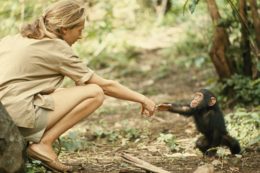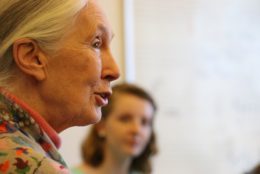Dr. Jane Goodall, considered the world’s foremost expert on chimpanzees, visited T.C. Williams High School on Friday to plant a tree and connect with students inspired by her Roots and Shoots program.
 The ethologist, who worked with anthropologist Louis Leakey in Africa at the time when the first connections were being made between apes and early humans, received a standing ovation as she told students to never forget that they make an impact on the world every day and that only they have the choice over what that impact is.
The ethologist, who worked with anthropologist Louis Leakey in Africa at the time when the first connections were being made between apes and early humans, received a standing ovation as she told students to never forget that they make an impact on the world every day and that only they have the choice over what that impact is.
There is a window of time to do something about the impact we are having on our planet. The biggest difference between us and chimpanzees is the explosion of our intellect. Chimpanzees cannot compare with a species that has gone to Mars. Chimps communicate but they cannot discuss. They can’t plan something ten years ahead or teach their children about the impact of something they are about to do. So don’t you find it crazy that a species with such intellect is destroying the planet?” Dr. Goodall told the packed auditorium at T.C. Williams.
 Dr. Goodall told how she fell in love with Africa through books as child. When she was eight, she read Dr. Dolittle by Hugh Lofting and became fascinated with the idea of returning animals to their original environment in Africa. She then read Tarzan by Edgar Rice Burroughs and fell passionately in love with Tarzan. “Except then he married the wrong Jane,” she joked.
Dr. Goodall told how she fell in love with Africa through books as child. When she was eight, she read Dr. Dolittle by Hugh Lofting and became fascinated with the idea of returning animals to their original environment in Africa. She then read Tarzan by Edgar Rice Burroughs and fell passionately in love with Tarzan. “Except then he married the wrong Jane,” she joked.
When she was four she spent a week on her grandmother’s farm and spent four and a half hours hiding in an empty chicken coop until she could discover the secret of how a chicken laid an egg. When she was 18 months old she took a handful of earthworms to bed with her.
That is the key — curiosity, deciding to find things out for yourself and then not giving up – those elements were all there in the four-year-old. But I was lucky because my mother just listened to my story of where the egg comes from instead of telling me off for going missing for four hours. My mother taught me that if you really want something you must work really hard take advantage of opportunity and never give up,” Dr. Goodall said.
Dr. Goodall’s mother was her companion for four of the six months that she was assigned to study the behavior of chimpanzees for Louis Leakey in the 1960s in Gombe National Park in Tanzania, Africa. Her mother had just left when Dr. Goodall made the critical connection between chimpanzees, humans and tools.
It was a raining heavily when she spotted a chimpanzee using a blade of grass to eat termites out of a termite mound.
Through my binoculars I could see a chimp eating a termite using a grass stem as a tool. Then he switched to use a leafy twig. He had to peel off leaves to use as terminate stick. It was the moment we were man the tool maker. I immediately sent a message to Louis [Leakey] and he said, so we have to redefine tools or accept chimps as humans. It’s clear that there isn’t a sharp line dividing humans from the chimpanzees,” Dr. Goodall said.
She talked about how she had got to know each personality of the chimpanzees over her 55 years of studying them, of how she had watch the ones with brains outsmart the ones who just had muscle. She watched them using rocks as weapons to throw at each other and other types of tools to get at food more easily. She also observed that chimpanzees remain loyal to siblings and the mothers remain loyal to their offspring long after they have finished suckling at five years old.
In 1986, Dr. Goodall attended a conference in Chicago.
I went as a scientist and left as an activist. I attended sessions on conservation, saw chimps caught I snares and in cages all alone – these inquisitive social beings – waiting for someone to perform tests on them and I learned about the live animal trade. I later flew over Lake Tanganyika and saw the forest was surrounded by the deforestation of hills and farmland that was overly used and could not support the population. So I knew I had to do something,” Dr. Goodall said.
VIDEO: This amazing video documents the story of Wounda, one of the more than 160 chimpanzees living at the Jane Goodall Institute’s Tchimpounga Chimpanzee Rehabilitation Center in the Republic of Congo. Dr. Jane Goodall was on hand to witness Wounda’s emotional release, and now you can too.
Dr. Goodall set up a support program in 12 villages and worked with them on their healthcare, education and micro-credit needs. She also worked to create a buffer area between the people and chimpanzees living in Gombe National Park. The trees grew back and created a left corridor so that Gombe could be linked to other chimpanzee groups so as to encourage interbreeding. Her Institute is now working with 52 villages and the trees have grown back. She abandoned her comfortable life and now spends 300 days traveling around the world as an activist.
The Jane Goodall Roots and Shoots program was started in 1991 in Tanzania. Groups choose three projects to make the world a better place. The visit to T.C. Williams was arranged by staff who have connections with the Jane Goodall Institute and had helped establish the Roots and Shoots program at the high school.
Dr. Goodall talked to students about the impact of their pledge to stop using plastic water bottles and about the impact of plastic on the environment. She asked them to find something they are passionate about and follow it through to make a difference.
There is a reason for hope and that is our brain and the fact that we can hope. Never forget that every day you make an impact and you get to choose what kind of impact you make,” Dr. Goodall said.
VIDEO: Dr. Goodall shared the following video, which highlights Roots & Shoots, the global youth program she founded with a group of Tanzanian students in 1991.
